Estrus Detection and Dairy Cow Identification with Cascade Deep Learning for Augmented Reality-Ready Livestock Farming
Abstract
:1. Introduction
- Introduce a deep learning-based method to visually identify animals on a livestock farm;
- Introduce a deep learning-based method for detecting standing mounted and mounting behaviors, the primary and secondary signs of estrus behavior. This brings new technology to the dynamic structure of modern animal husbandry;
- Present a high-accuracy system by integrating estrus detection and cow identification processes through the proposed method.
2. Materials and Methods
2.1. Dataset and Transfer Learning for Mounting Detection
2.2. Dataset and Cow Identification
2.3. Deep Learning Architectures
2.3.1. Convolutional Neural Network (CNN)
2.3.2. VGG-19
2.3.3. YOLO
2.4. Deep Learning Performance Evaluation and Model Selection
3. Results and Discussion
3.1. Estrus Detection
3.1.1. Mounting Detection with CNN
3.1.2. Mounting Detection with VGG-19
3.1.3. Mounting Region of Interest Detection with YOLOv5
3.2. Cow Identification
3.3. Cascaded System Results
3.4. Comparison with Similar Studies
| Reference | Sensor | Estrus Detection | Cow Identification | Cost | Lifetime |
|---|---|---|---|---|---|
| Actimoo [29] | IMU | Pattern recognition from IMU signals obtained from cow collars | Smart collar matching with the ID of the dairy cow | ~EUR 120 per cow | 5 years battery life |
| SCR Heatime [33] | IMU | Pattern recognition from IMU signals obtained from cow collars | Smart collar matching with the ID of the dairy cow | ~EUR 200 per cow | 7 years battery life |
| Estrotect [30] | Paint | Patch that changes color when the cow mounts | Accomplished by seeing the painted cow by the farmer | EUR 2.5 per usage | Disposable |
| [28] | PTZ Camera | Faster R-CNN and SSD cow localization and tracking | NA | NA | No battery |
| [45] | Camera | Detection of cow images with deep learning (YOLOv5) | NA | NA | No battery |
| [46] | Multiple cameras | Detection of ewe images with deep learning (YOLOv3) | NA | NA | No battery |
| [47] | RFID | NA | Yes | Under EUR 1 per cow | No battery |
| [48] | IMU and RFID | NA | Yes | Under EUR 20 per cow | Rechargeable Li-Po (728 days) |
| Proposed method | Camera | Detection of cow images with deep learning | Classification of images with deep learning | NA | No battery |
| Reference | Sensor | Software | Estrus Detection Accuracy (%) | Cow Identification Accuracy (%) |
|---|---|---|---|---|
| [23] | IMU | Fuzzy logic model | 98 | NA |
| [27] | IMU | Deep learning | 97 | NA |
| [29] | IMU | NA | 80 | NA |
| [28] | Camera | Deep learning | 94 | NA |
| [45] | Camera | Detection of cow images with Deep learning (YOLOv5) | 94.3 | NA |
| [49] | Camera | Computer vision | 90.9 | NA |
| [50] | Camera | YOLOv3 | 82.1 | NA |
| [51] | Camera and ear tag | CNN | NA | 84 |
| [52] | Camera | YOLO and faster R-CNN | NA | 84.4 |
| Proposed CNN model | Camera | Deep learning | 98 | NA |
| Proposed VGG-19 model | Camera | Deep learning | 99 | NA |
| Proposed YOLO model | Camera | Deep learning | 98 | 95 |
4. Conclusions and Future Works
Author Contributions
Funding
Institutional Review Board Statement
Informed Consent Statement
Data Availability Statement
Acknowledgments
Conflicts of Interest
References
- Araújo, S.O.; Peres, R.S.; Barata, J.; Lidon, F.; Ramalho, J.C. Characterising the Agriculture 4.0 Landscape—Emerging Trends, Challenges and Opportunities. Agronomy 2021, 11, 667. [Google Scholar] [CrossRef]
- Symeonaki, E.; Arvanitis, K.G.; Loukatos, D.; Piromalis, D. Enabling IoT Wireless Technologies in Sustainable Livestock Farming Toward Agriculture 4.0. In IoT-Based Intelligent Modelling for Environmental and Ecological Engineering: IoT Next Generation EcoAgro Systems; Krause, P., Xhafa, F., Eds.; Lecture Notes on Data Engineering and Communications Technologies; Springer International Publishing: Cham, Switzerland, 2021; pp. 213–232. ISBN 978-3-030-71172-6. [Google Scholar]
- Liu, Y.; Ma, X.; Shu, L.; Hancke, G.P.; Abu-Mahfouz, A.M. From Industry 4.0 to Agriculture 4.0: Current Status, Enabling Technologies, and Research Challenges. IEEE Trans. Ind. Inform. 2021, 17, 4322–4334. [Google Scholar] [CrossRef]
- Hurst, W.; Mendoza, F.R.; Tekinerdogan, B. Augmented Reality in Precision Farming: Concepts and Applications. Smart Cities 2021, 4, 1454–1468. [Google Scholar] [CrossRef]
- Caria, M.; Todde, G.; Sara, G.; Piras, M.; Pazzona, A. Performance and Usability of Smartglasses for Augmented Reality in Precision Livestock Farming Operations. Appl. Sci. 2020, 10, 2318. [Google Scholar] [CrossRef]
- Caria, M.; Sara, G.; Todde, G.; Polese, M.; Pazzona, A. Exploring Smart Glasses for Augmented Reality: A Valuable and Integrative Tool in Precision Livestock Farming. Animals 2019, 9, 903. [Google Scholar] [CrossRef]
- Zhao, Z.; Yang, W.; Chinthammit, W.; Rawnsley, R.; Neumeyer, P.; Cahoon, S. A New Approach to Utilize Augmented Reality on Precision Livestock Farming. In Proceedings of the ICAT-EGVE, Adelaide, Australia, 22–24 November 2017; pp. 185–188. [Google Scholar]
- Lee, S.; Lee, J.; Lee, A.; Park, N.; Lee, S.; Song, S.; Seo, A.; Lee, H.; Kim, J.-I.; Eom, K. Augmented Reality Intravenous Injection Simulator Based 3D Medical Imaging for Veterinary Medicine. Vet. J. 2013, 196, 197–202. [Google Scholar] [CrossRef] [PubMed]
- Little, W.B.; Dezdrobitu, C.; Conan, A.; Artemiou, E. Is Augmented Reality the New Way for Teaching and Learning Veterinary Cardiac Anatomy? Med. Sci. Educ. 2021, 31, 723–732. [Google Scholar] [CrossRef]
- Morrone, S.; Dimauro, C.; Gambella, F.; Cappai, M.G. Industry 4.0 and Precision Livestock Farming (PLF): An up to Date Overview across Animal Productions. Sensors 2022, 22, 4319. [Google Scholar] [CrossRef]
- Kraft, M.; Bernhardt, H.; Brunsch, R.; Büscher, W.; Colangelo, E.; Graf, H.; Marquering, J.; Tapken, H.; Toppel, K.; Westerkamp, C.; et al. Can Livestock Farming Benefit from Industry 4.0 Technology? Evidence from Recent Study. Appl. Sci. 2022, 12, 12844. [Google Scholar] [CrossRef]
- Pandey, S.; Kalwa, U.; Kong, T.; Guo, B.; Gauger, P.C.; Peters, D.J.; Yoon, K.-J. Behavioral Monitoring Tool for Pig Farmers: Ear Tag Sensors, Machine Intelligence, and Technology Adoption Roadmap. Animals 2021, 11, 2665. [Google Scholar] [CrossRef]
- Zhao, K.; Jin, X.; Ji, J.; Wang, J.; Ma, H.; Zhu, X. Individual Identification of Holstein Dairy Cows Based on Detecting and Matching Feature Points in Body Images. Biosyst. Eng. 2019, 181, 128–139. [Google Scholar] [CrossRef]
- Zin, T.T.; Phyo, C.N.; Tin, P.; Hama, H.; Kobayashi, I. Image Technology Based Cow Identification System Using Deep Learning. In Proceedings of the International Multiconference of Engineers and Computer Scientists, Hong Kong, 14–16 March 2018; Volume 1, pp. 236–247. [Google Scholar]
- Xiao, J.; Liu, G.; Wang, K.; Si, Y. Cow Identification in Free-Stall Barns Based on an Improved Mask R-CNN and an SVM. Comput. Electron. Agric. 2022, 194, 106738. [Google Scholar] [CrossRef]
- Kumar, S.; Singh, S.K.; Singh, A.K. Muzzle Point Pattern Based Techniques for Individual Cattle Identification. IET Image Process. 2017, 11, 805–814. [Google Scholar] [CrossRef]
- Bello, R.W.; Olubummo, D.A.; Seiyaboh, Z.; Enuma, O.C.; Talib, A.Z.; Mohamed, A.S.A. Cattle Identification: The History of Nose Prints Approach in Brief. IOP Conf. Ser. Earth Environ. Sci. 2020, 594, 012026. [Google Scholar] [CrossRef]
- Yang, L.; Xu, X.; Zhao, J.; Song, H. Fusion of RetinaFace and Improved FaceNet for Individual Cow Identification in Natural Scenes. Inf. Process. Agric. 2023. [Google Scholar] [CrossRef]
- Roelofs, J.; López-Gatius, F.; Hunter, R.H.F.; van Eerdenburg, F.J.C.M.; Hanzen, C. When Is a Cow in Estrus? Clinical and Practical Aspects. Theriogenology 2010, 74, 327–344. [Google Scholar] [CrossRef] [PubMed]
- Remnant, J.G.; Green, M.J.; Huxley, J.N.; Hudson, C.D. Associations between Dairy Cow Inter-Service Interval and Probability of Conception. Theriogenology 2018, 114, 324–329. [Google Scholar] [CrossRef] [PubMed]
- Reith, S.; Hoy, S. Review: Behavioral Signs of Estrus and the Potential of Fully Automated Systems for Detection of Estrus in Dairy Cattle. Animal 2018, 12, 398–407. [Google Scholar] [CrossRef]
- Fricke, P.M.; Carvalho, P.D.; Giordano, J.O.; Valenza, A.; Lopes, G.; Amundson, M.C. Expression and Detection of Estrus in Dairy Cows: The Role of New Technologies. Animal 2014, 8, 134–143. [Google Scholar] [CrossRef]
- Memmedova, N.; Keskin, İ. Oestrus Detection by Fuzzy Logic Model Using Trait Activity in Cows. Kafkas Üniversitesi Vet. Fakültesi Derg. 2011, 17, 1003–1008. [Google Scholar] [CrossRef]
- Bayril, T.; Yilmaz, O.; Çak, B. Effect of Timing of Artificial Insemination Relative to Spontaneous Estrus on Reproductive Performance and Calf Gender Ratio in Repeat Breeder Holstein Cows. JAPS J. Anim. Plant Sci. 2016, 26, 34123459. [Google Scholar]
- Kaya, A.; Güneş, E.; Memili, E. Application of Reproductive Biotechnologies for Sustainableproduction of Livestock in Turkey. Turk. J. Vet. Anim. Sci. 2018, 42, 143–151. [Google Scholar]
- Koçyiğit, R.; Yanar, M.; Diler, A.; Aydın, R.; ÖZDEMİR, V.F.; Yılmaz, A. Cattle and Calf Raising Practices in The Eastern Anatolia Region: An Example of Central County of Ağrı Province. Int. J. Agric. Nat. Sci. 2021, 14, 152–163. [Google Scholar]
- Yıldız, A.K.; Özgüven, M.M. Determination of Estrus in Cattle with Artificial Neural Networks Using Mobility and Environmental Data. J. Agric. Fac. Gaziosmanpaşa Univ. (JAFAG) 2022, 39, 40–45. [Google Scholar] [CrossRef]
- Arago, N.M.; Alvarez, C.I.; Mabale, A.G.; Legista, C.G.; Repiso, N.E.; Robles, R.R.A.; Amado, T.M.; Romeo, L.J., Jr.; Thio-ac, A.C.; Velasco, J.S. Automated Estrus Detection for Dairy Cattle through Neural Networks and Bounding Box Corner Analysis. Int. J. Adv. Comput. Sci. Appl. 2020, 11, 935. [Google Scholar] [CrossRef]
- ActimooTM Actimoo Estrus Detection System. Available online: https://www.actimoo.com (accessed on 1 October 2023).
- EstrotectTM|Breed with Confidence. Available online: https://estrotect.com/ (accessed on 3 September 2023).
- Benaissa, S.; Tuyttens, F.A.M.; Plets, D.; Trogh, J.; Martens, L.; Vandaele, L.; Joseph, W.; Sonck, B. Calving and Estrus Detection in Dairy Cattle Using a Combination of Indoor Localization and Accelerometer Sensors. Comput. Electron. Agric. 2020, 168, 105153. [Google Scholar] [CrossRef]
- Wang, J.; Bell, M.; Liu, X.; Liu, G. Machine-Learning Techniques Can Enhance Dairy Cow Estrus Detection Using Location and Acceleration Data. Animals 2020, 10, 1160. [Google Scholar] [CrossRef] [PubMed]
- SCR Heatime|Micro Technologies. Available online: https://www.microtechnologies.com/dairy/heatime (accessed on 3 September 2023).
- Dallago, G.M.; Wade, K.M.; Cue, R.I.; McClure, J.T.; Lacroix, R.; Pellerin, D.; Vasseur, E. Keeping Dairy Cows for Longer: A Critical Literature Review on Dairy Cow Longevity in High Milk-Producing Countries. Animals 2021, 11, 808. [Google Scholar] [CrossRef]
- Sehested, J.; Gaillard, C.; Lehmann, J.O.; Maciel, G.M.; Vestergaard, M.; Weisbjerg, M.R.; Mogensen, L.; Larsen, L.B.; Poulsen, N.A.; Kristensen, T. Review: Extended Lactation in Dairy Cattle. Animal 2019, 13, s65–s74. [Google Scholar] [CrossRef]
- Webster, J. Understanding the Dairy Cow; John Wiley & Sons: Hoboken, NJ, USA, 2020; ISBN 978-1-119-55022-8. [Google Scholar]
- Shorten, C.; Khoshgoftaar, T.M. A Survey on Image Data Augmentation for Deep Learning. J Big Data 2019, 6, 60. [Google Scholar] [CrossRef]
- LeCun, Y.; Bengio, Y. Convolutional Networks for Images, Speech, and Time Series. Handb. Brain Theory Neural Netw. 1995, 3361, 1995. [Google Scholar]
- Li, Z.; Liu, F.; Yang, W.; Peng, S.; Zhou, J. A Survey of Convolutional Neural Networks: Analysis, Applications, and Prospects. IEEE Trans. Neural Netw. Learn. Syst. 2021, 33, 6999–7019. [Google Scholar] [CrossRef]
- Simonyan, K.; Zisserman, A. Very Deep Convolutional Networks for Large-Scale Image Recognition. arXiv 2015, arXiv:1409.1556. [Google Scholar]
- Nguyen, T.-H.; Nguyen, T.-N.; Ngo, B.-V. A VGG-19 Model with Transfer Learning and Image Segmentation for Classification of Tomato Leaf Disease. AgriEngineering 2022, 4, 871–887. [Google Scholar] [CrossRef]
- Redmon, J.; Divvala, S.; Girshick, R.; Farhadi, A. You Only Look Once: Unified, Real-Time Object Detection. arXiv 2016, arXiv:1506.02640. [Google Scholar]
- Jiang, P.; Ergu, D.; Liu, F.; Cai, Y.; Ma, B. A Review of Yolo Algorithm Developments. Procedia Comput. Sci. 2022, 199, 1066–1073. [Google Scholar] [CrossRef]
- Gaude, I.; Kempf, A.; Strüve, K.D.; Hoedemaker, M. Estrus Signs in Holstein Friesian Dairy Cows and Their Reliability for Ovulation Detection in the Context of Visual Estrus Detection. Livest. Sci. 2021, 245, 104449. [Google Scholar] [CrossRef]
- Wang, R.; Gao, Z.; Li, Q.; Zhao, C.; Gao, R.; Zhang, H.; Li, S.; Feng, L. Detection Method of Cow Estrus Behavior in Natural Scenes Based on Improved YOLOv5. Agriculture 2022, 12, 1339. [Google Scholar] [CrossRef]
- Yu, L.; Pu, Y.; Cen, H.; Li, J.; Liu, S.; Nie, J.; Ge, J.; Lv, L.; Li, Y.; Xu, Y.; et al. A Lightweight Neural Network-Based Method for Detecting Estrus Behavior in Ewes. Agriculture 2022, 12, 1207. [Google Scholar] [CrossRef]
- Samad, A.; Murdeshwar, P.; Hameed, Z. High-Credibility RFID-Based Animal Data Recording System Suitable for Small-Holding Rural Dairy Farmers. Comput. Electron. Agric. 2010, 73, 213–218. [Google Scholar] [CrossRef]
- Achour, B.; Belkadi, M.; Saddaoui, R.; Filali, I.; Aoudjit, R.; Laghrouche, M. High-Accuracy and Energy-Efficient Wearable Device for Dairy Cows’ Localization and Activity Detection Using Low-Cost IMU/RFID Sensors. Microsyst. Technol. 2022, 28, 1241–1251. [Google Scholar] [CrossRef]
- Guo, Y.; Zhang, Z.; He, D.; Niu, J.; Tan, Y. Detection of Cow Mounting Behavior Using Region Geometry and Optical Flow Characteristics. Comput. Electron. Agric. 2019, 163, 104828. [Google Scholar] [CrossRef]
- Fuentes, A.; Yoon, S.; Park, J.; Park, D.S. Deep Learning-Based Hierarchical Cattle Behavior Recognition with Spatio-Temporal Information. Comput. Electron. Agric. 2020, 177, 105627. [Google Scholar] [CrossRef]
- Zin, T.T.; Misawa, S.; Pwint, M.Z.; Thant, S.; Seint, P.T.; Sumi, K.; Yoshida, K. Cow Identification System Using Ear Tag Recognition. In Proceedings of the 2020 IEEE 2nd Global Conference on Life Sciences and Technologies (LifeTech), Kyoto, Japan, 10–12 March 2020; pp. 65–66. [Google Scholar]
- Nguyen, C.; Wang, D.; Von Richter, K.; Valencia, P.; Alvarenga, F.A.P.; Bishop–Hurley, G. Video-Based Cattle Identification and Action Recognition. In Proceedings of the 2021 Digital Image Computing: Techniques and Applications (DICTA), Gold Coast, Australia, 29 November–1 December 2021; pp. 1–5. [Google Scholar]

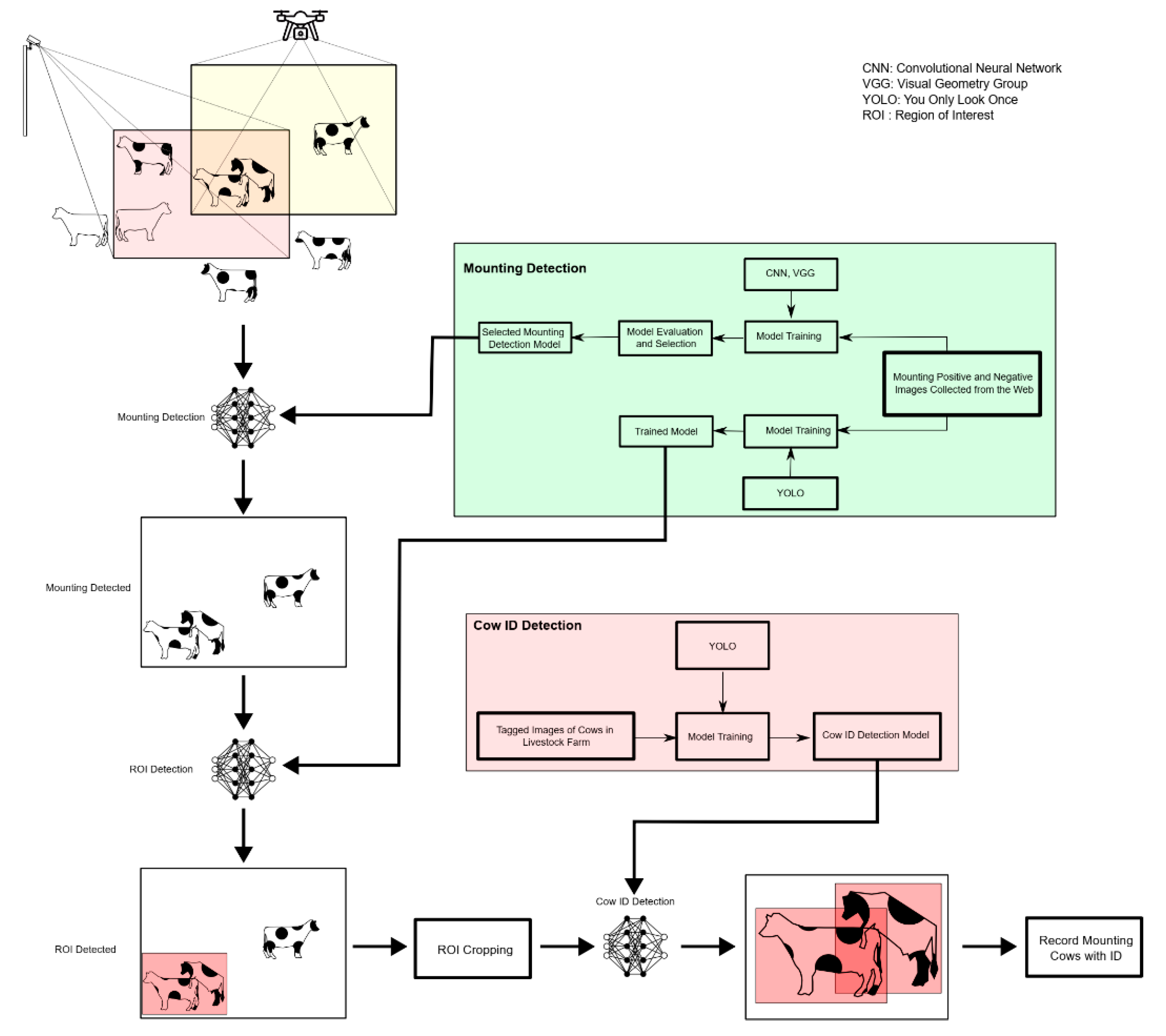
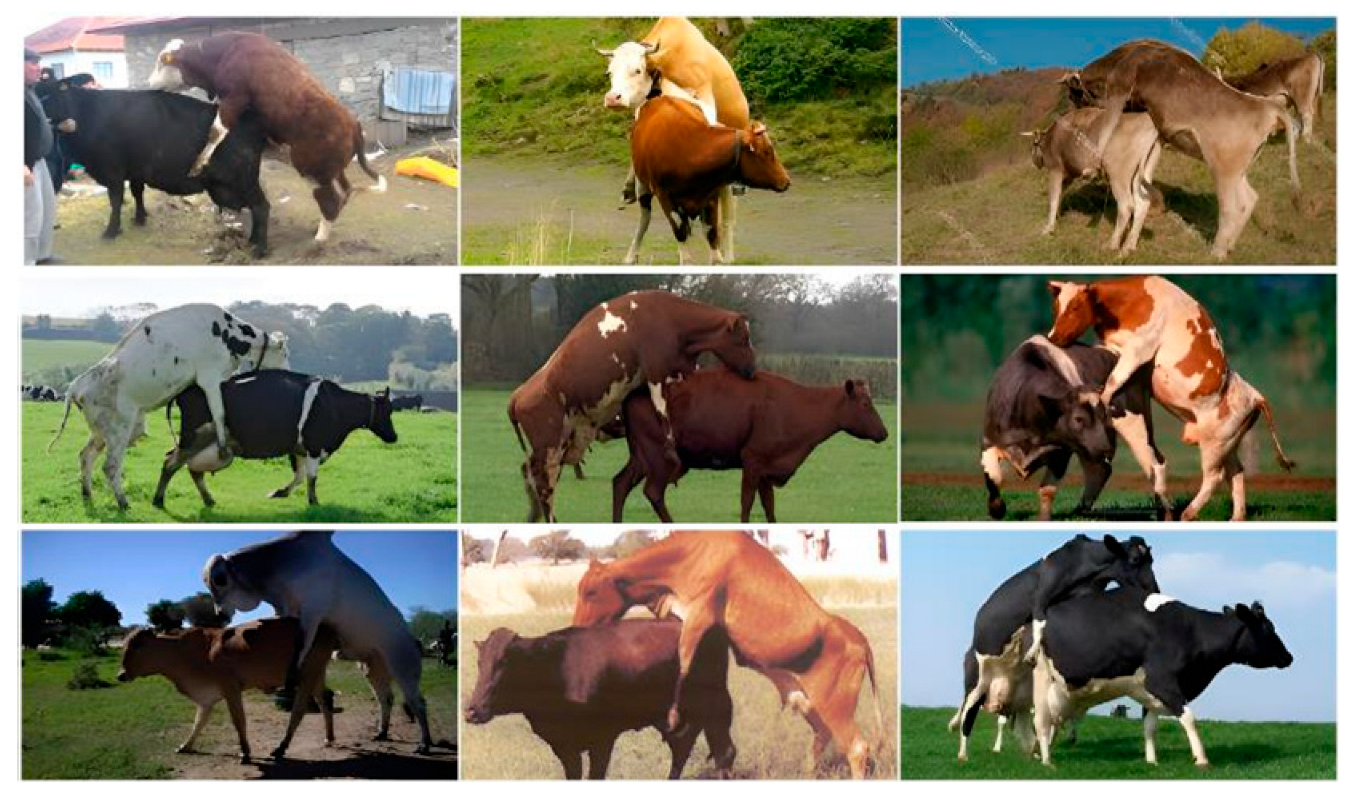

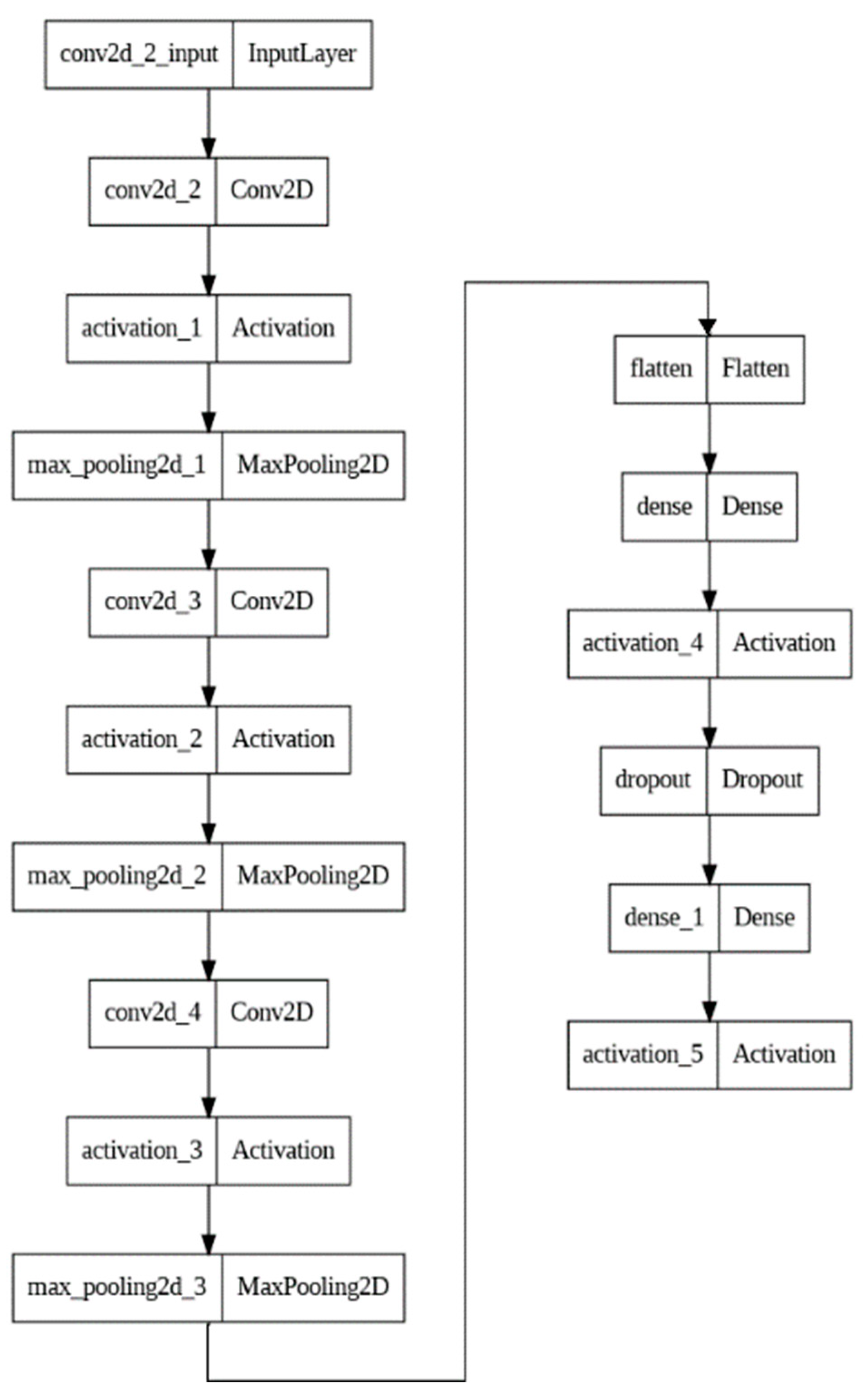


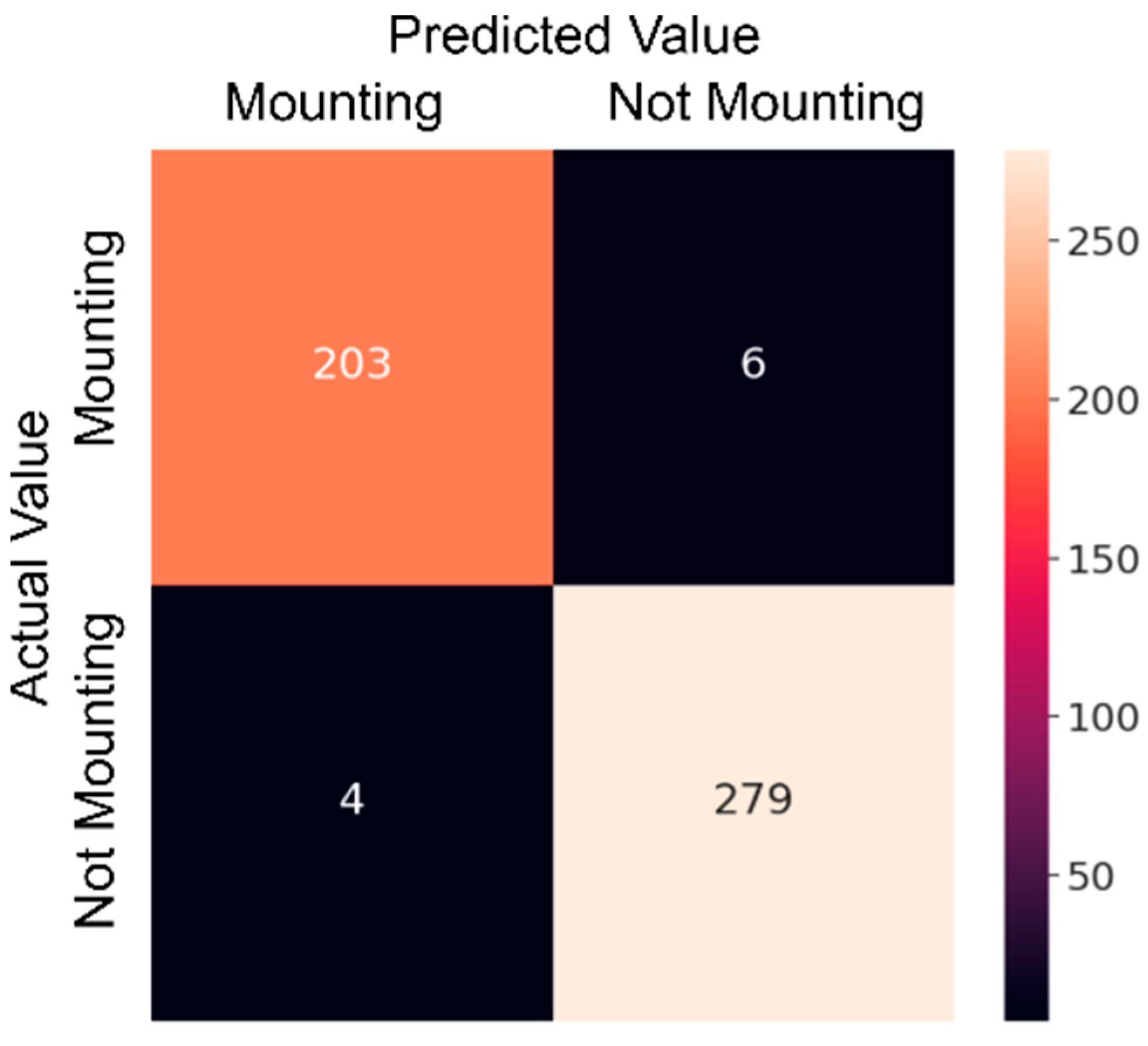


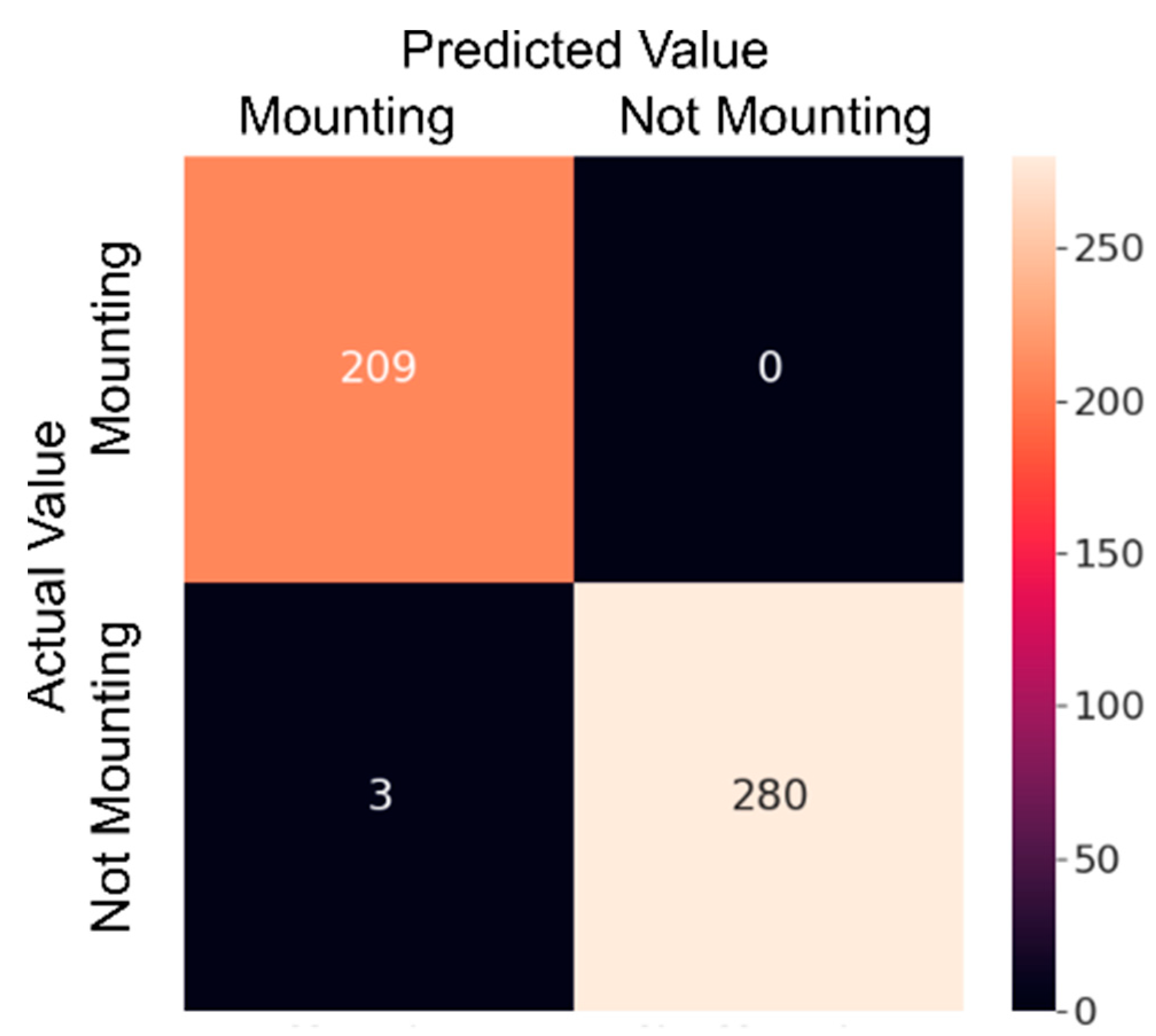





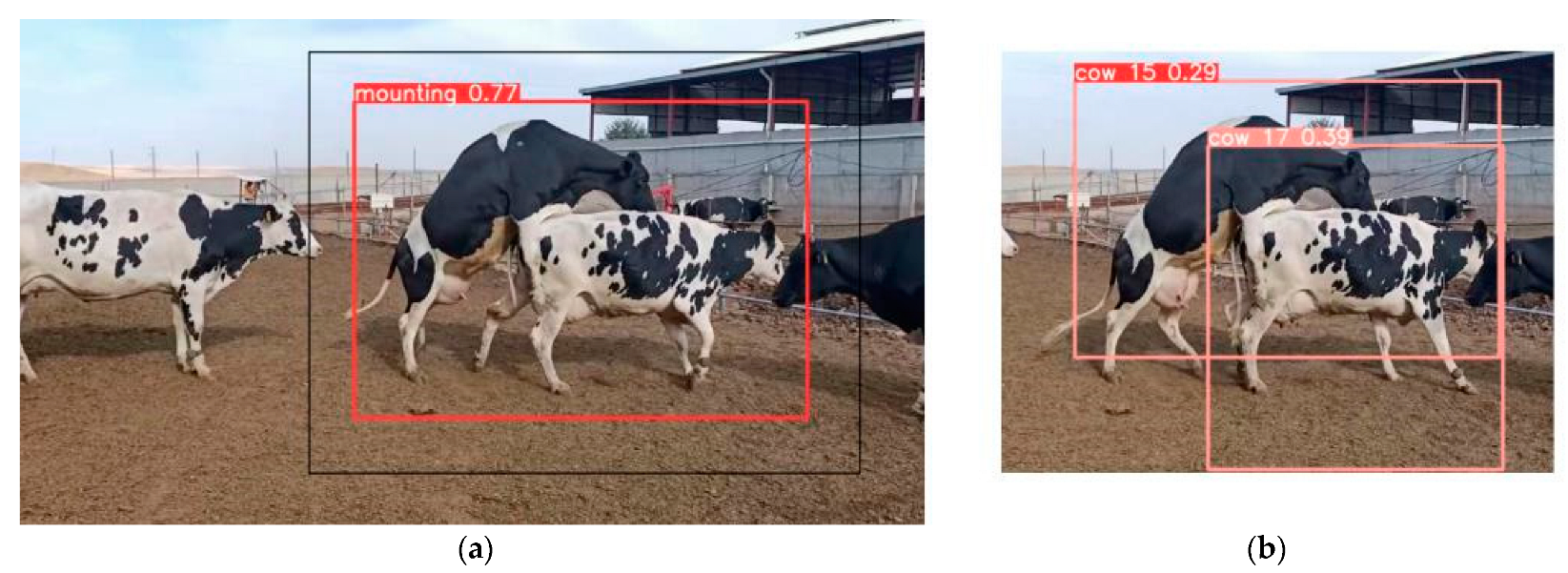
| Model | Loss Function | Optimizer | Performance Metric | Train Data (%) | Validation Data (%) | Epoch | Mini-Batch Size | Learning Rate |
|---|---|---|---|---|---|---|---|---|
| CNN | Binary crossentropy | Rmsprop | Accuracy | 70 | 30 | 20 | 32 | 0.001 |
| VGG-19 | Binary crossentropy | Rmsprop | Accuracy | 70 | 30 | 20 | 32 | 0.001 |
| YOLO | Binary crossentropy | Rmsprop | Accuracy | 70 | 30 | 150 | 16 | 0.001 |
| Metric | Equation |
|---|---|
| Accuracy | |
| Precision | |
| Recall | |
| F1 Score |
| Model | Accuracy (%) | Precision (%) | Recall (%) | F1 Score (%) |
|---|---|---|---|---|
| CNN | 98 | 97 | 98 | 97 |
| VGG-19 | 99 | 99 | 98 | 99 |
| YOLO | 98 | 98 | 98 | 97 |
Disclaimer/Publisher’s Note: The statements, opinions and data contained in all publications are solely those of the individual author(s) and contributor(s) and not of MDPI and/or the editor(s). MDPI and/or the editor(s) disclaim responsibility for any injury to people or property resulting from any ideas, methods, instructions or products referred to in the content. |
© 2023 by the authors. Licensee MDPI, Basel, Switzerland. This article is an open access article distributed under the terms and conditions of the Creative Commons Attribution (CC BY) license (https://creativecommons.org/licenses/by/4.0/).
Share and Cite
Arıkan, İ.; Ayav, T.; Seçkin, A.Ç.; Soygazi, F. Estrus Detection and Dairy Cow Identification with Cascade Deep Learning for Augmented Reality-Ready Livestock Farming. Sensors 2023, 23, 9795. https://doi.org/10.3390/s23249795
Arıkan İ, Ayav T, Seçkin AÇ, Soygazi F. Estrus Detection and Dairy Cow Identification with Cascade Deep Learning for Augmented Reality-Ready Livestock Farming. Sensors. 2023; 23(24):9795. https://doi.org/10.3390/s23249795
Chicago/Turabian StyleArıkan, İbrahim, Tolga Ayav, Ahmet Çağdaş Seçkin, and Fatih Soygazi. 2023. "Estrus Detection and Dairy Cow Identification with Cascade Deep Learning for Augmented Reality-Ready Livestock Farming" Sensors 23, no. 24: 9795. https://doi.org/10.3390/s23249795
APA StyleArıkan, İ., Ayav, T., Seçkin, A. Ç., & Soygazi, F. (2023). Estrus Detection and Dairy Cow Identification with Cascade Deep Learning for Augmented Reality-Ready Livestock Farming. Sensors, 23(24), 9795. https://doi.org/10.3390/s23249795








